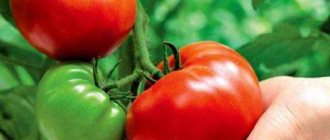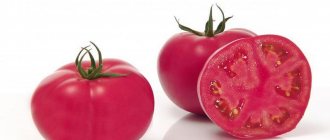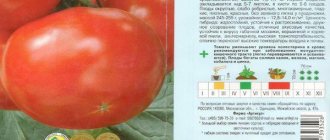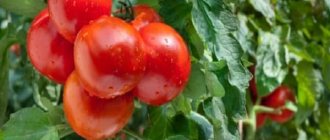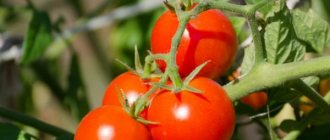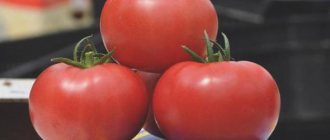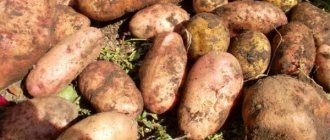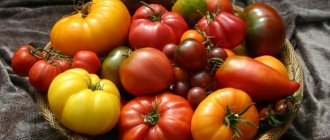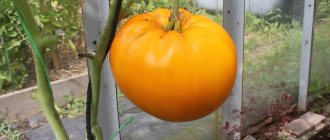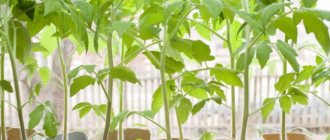It was not for nothing that the tomato Uncle Styopa received its name in honor of the kind giant character. It has tall bushes, elongated long fruits that contain little juice, and a wonderful taste.
| Height | Landing location | Ripening time | Fruit color | Fruit size | Origin | Fruit shape |
| Tall | Greenhouse, Open ground | Mid-early | Reds | Average | Variety | Pepper-shaped |
Description of the variety
Fruit:
- They have a shape atypical for tomatoes. More similar to bananas - elongated, with an oval cross-section and a slightly pointed tip;
- Having reached varietal maturity, deep red in color;
- With thin but dense skin;
- The number of seed chambers is from 3 to 5;
Under optimal conditions, the weight of the fruit can be up to 300 grams.
- High content of dry and starchy substances;
- Reaches up to 20 cm in length;
- Average weight - 180 grams.
Bushes:
- Indeterminate, medium leafy plant;
- It can reach a height of 1.5 to 2.5 meters;
- Leaves are medium sized, green in color;
- The inflorescences are simple.
Description and characteristics of the tomato Uncle Styopa, reviews, photos
Mid-season, indeterminate, cluster tomato variety from Siberian breeders. In the middle zone it is recommended to grow it in greenhouses.
The bush is up to 1.8 meters high, has medium foliage, requires tying to a support and pinching. The best results were obtained when forming a plant with 1 or 2 stems. The fruits are collected in simple clusters of 3-5 fruits.
Basic qualities of fruits
The fruits are elongated, with a “spout”, can be slightly curved, dense, practically without liquid, red in color at maturity, weighing 150-200 grams, excellent taste. These tomatoes are suitable for both canning and fresh consumption.
Productivity of the Uncle Styopa variety: up to 4 kg per plant (subject to agricultural practices).
Tomatoes: advantages and disadvantages
The tomato variety “Uncle Styopa” has the following positive qualities:
- Good yield;
- Immunity to major tomato diseases;
- Excellent taste characteristics, thanks to the optimal starch content and the complete absence of juice;
- Good tolerance to short-term temperature drops;
- Resistant to cracking;
- Possibility of transportation;
- Excellent keeping quality;
- Rich in unique compounds (acids, antioxidants, starch), vitamins PP, K, as well as provitamin A. In addition, tomatoes contain microelements: potassium, iron, phosphorus, magnesium, sodium.
The disadvantages of this variety include the need for weekly pinching and the need to tie the bush to trellises. A characteristic feature of the “Uncle Styopa” tomato is that if there is a deficiency of the required amount of moisture, the tomato fruits become small and hollow inside.
Real reviews from ordinary gardeners
You can read many reviews left by people who grow tomatoes of the “Uncle Styopa” variety. Let's look at the three most frequently encountered, out of a large number of positive reviews:
Alexey Konstantinovich, 66 years old, Orel:
“I lived in the Far North for a long time. Recently moved to Orel. When purchasing, they offered to take tomato seeds of the “Uncle Styopa” variety. I was amazed at the abundance of tomatoes ripening on the bushes at the same time. Each tomato weighed more than 300 g. The bushes simply bent from the weight of the fruit. I recommend it, you definitely won’t be disappointed!”
Antonina Karlovna, 37 years old, Volgograd:
“I recently purchased Uncle Styopa tomatoes on the advice of a friend. Planted it. But then I had family problems. I didn't think about tomatoes. After a while I came to the station and gasped. The bushes bent under the weight of the tomatoes. I tasted it. The fruits were tasty and aromatic. So don’t believe fairy tales after this! I will definitely raise “Uncle Styopa” in the future.”
Ekaterina, 35 years old, Tver region:
“I decided to try new varieties. I bought “Uncle Styopa”. The fruits are simply huge and delicious. Excellent for making lecho, and any other preserved food. The tomato has only one drawback: you cannot squeeze juice out of it. Even bad weather does not affect the harvest. I recommend."
The tomatoes are gigantic, tasty and original. With a minimum of costs, the harvest is off the charts in volume. Experienced gardeners grow it on their plots.
Growing tomatoes
It is preferable to grow the “Uncle Styopa” variety through seedlings.
How to grow tomatoes in a greenhouse:
How to prepare seeds?
Preparation of seed material:
- Pre-sowing disinfection of seed material is mandatory in order to reduce the risk of the possible occurrence of various pathogenic diseases. To do this, the seeds are placed in a manganese solution. Afterwards, the seed material must be rinsed well under running water and slightly dried;
- To ensure uniform emergence of seedlings, the planting material is treated with an aqueous solution of aloe and a growth stimulant;
- It is better to use germinated seeds for sowing. For this purpose, they are placed in a damp cloth and left in a warm place. The seed material should be kept warm for 3-5 days. The moisture content of the material is monitored daily and water is added if necessary.
Sowing seed material
Instructions on how to sow seeds:
- Sowing of seed material begins 60-65 days before the planned planting of seedlings in a permanent place;
- Planting containers are filled with the required amount of soil, to which wood ash and various fertilizers are added. To disinfect the soil, the containers are placed in the oven and heated to 150-200 ºС. At this temperature, they are left in the oven for two hours. Then they take out the containers and wait for the soil to cool;
- The required seed sowing depth is from 1.5 to 2 cm;
- Containers with plantings are placed in a room with a temperature regime of at least +22 ºС;
- Watering is carried out regularly, preventing the soil from drying out. Avoid excessive watering, as excess moisture causes abnormal growth of seedlings;
- As soon as the first shoots appear, the seedlings are moved closer to the light source. An additional source of lighting will be fluorescent lamps;
- The seedlings are hardened off for 7-10 days before planting. The seedlings are first taken out into the open air for half an hour a day, gradually increasing the period of stay on the street.
Rules for planting seedlings
How to plant seedlings correctly:
- Planting is carried out after stable warm weather has established;
- It is good to plant tomatoes in beds where cabbage, cucumbers, and green manure plants previously grew;
- The bed must be prepared before planting. The bed is dug up, adding a sufficient amount of fertilizer;
- The width between rows should be at least 50 cm, the interval between planting holes should be 40 cm. Immediately before planting, pegs are installed near each hole for further tying;
- Each hole is spilled with water and filled with organic fertilizer. Afterwards, a seedling is placed in the hole and, straightening the roots, it is covered with the required amount of soil. Next, water the plantings with water;
- It is recommended to place no more than three seedlings per 1 m2. Thanks to this, you can get a harvest of large tomatoes.
“Uncle Styopa” tomatoes, cucumber and grapes. Revda residents showed that they grew up in the summer
Not a day goes by without our readers boasting about new garden wonders. Super potatoes, mega radishes, miracle tomatoes... We tell you about all the achievements of the city residents' gardening, which they shared with us! We also invite you to take part in a competition with prizes: we will give gifts for the best story!
Participate in the photo competition “This is what I grew!”
Until October 20, send photos of the harvest - or bring the harvest itself so that we can photograph you in the editorial office.
Requirements for competitive works:
- You definitely need to capture a person in the photo: if it’s a miracle tomato, let someone hold it in their hands.
- Tell us about your harvest: what did you grow? Where? What are your gardening secrets? What did you feed them, when did you plant them, when did you harvest your crops? The more interesting the story, the higher the chances of winning!
- Be sure to indicate who is in the photo, who is the gardener, and how to contact you.
We will sum up the results on October 21. The three best authors will receive gifts from the editors!
Send photos and your stories to the email address [email protected] Or bring them to the editorial office at P. Zykina, 32, office 208 on weekdays from 9 a.m. to 7 p.m. or on Saturday from 10 a.m. to 4 p.m.
Alina Shchekotova and watermelon
Alina says:
— My grandmother used to constantly plant watermelons in her garden in the greenhouse. And hers always grew to be about the size of a small ball. And we also decided to try to plant it that year, and it worked. We collected about 10 watermelons.
This year the summer was colder, so only two grew, one very small and the second normal. Just bought watermelon seeds at the store. They planted them in a greenhouse next to the cucumbers. They didn't feed me anything special. We plant the seeds in pots in the spring and plant them in the greenhouse in June.
That's all. We only water. Watering every day.
Egor Pikulev and apples
This is Egor, and his mother Masha and father Dima Pikulev grow apples and pears. Their plot is in the garden of SUMZ-5. The couple collected a KAMAZ of apples this year! They make pastille, jam, compotes, marmalade, and dry them for the winter.
Sometimes they serve wine. The remainder is distributed to relatives. Dmitry says that he simply buried several seedlings of apple and pear trees several years ago, and they bore fruit. This is such beauty! There are also delicious raspberries growing on the plot.
Elena Marentseva and cucumber
Elena first tried this hybrid with friends. Last year. Then I bought seeds and planted them in a greenhouse. Three have grown. Care is the simplest: water with warm water. It tastes and smells like sweet melon. Elena also has cedar trees; 22 years ago her father brought her a bush from Surgut. The bumps only appeared the year before.
Tatyana Tolmacheva, melons and grapes
Tatyana takes care of the garden on Baranovka. In April, he plants melons of the “Kolkhoznitsa” variety and watermelons of the “Sugar Baby” variety in the greenhouse.
At the seedling stage, it is fed with liquid mineral fertilizers (Kemira Lux, for example), and in the summer, while the vines are growing, with natural fertilizers (for example, nettle infusion). Tatyana also grows Ural grapes “Aleshenkin”.
I planted the vines five years ago, the winter before last it froze, but now it has withered away and even produced a harvest (several tassels). And this year there was a magnificent harvest of tomatoes! The most delicious are “Uncle Styopa”.
Olga Matsueva and potatoes
Olga helps her parents in the vegetable garden, which is located at State Farm. At the end of May, they planted potatoes, did not water, did not fertilize, but often watered and hilled... And they removed 260 buckets.
The potatoes are large, very tasty, not sweet or sour, and boil well. The harvest this year is good, previously it was smaller. The three of us cleaned for three days, sold some of it, and will eat the rest.
It will definitely be enough until spring. Well, let's board.
Svetlana Belaya and beets
Svetlana says that her family lives in their own house. We bought beet seeds at the Dachnik store, planted them in June, and watered them with water from a well. And we were very surprised when we saw what grew in the end. The largest specimen pulled 2.5 kg! For many years, Svetlana says, this is the first time such a rich harvest.
Olesya Bashkirtseva and a little bit of everything
Alexey, Olesya’s son, shows the beets grown by his mother.
Olesya says to herself that she is an amateur gardener, a lazy experimenter. She doesn't need any extra trouble. But he loves variety, so he plants a little of everything.
— I grow perennial flowers or those whose seedlings do not require care: godetia, calendula, cornflowers, petunia. We grow everything according to the system: natural selection of nature. I don't have much time to garden. Appeared in the garden beds only on weekends. Nature itself regulated everything: both light and watering.
But of course this won’t work with a greenhouse. Therefore, in the middle of the week, my husband’s parents would help us out with watering. Every year I buy different seeds, frankly speaking, I don’t even remember.
But I’m lucky with the taste of vegetables: no matter what I plant, it’s always delicious)) For fertilizing, we occasionally use manure and green manure in the fall.
The family's dacha is located near Volchikha, right next to the forest, and the cultivated plants there are fighting for survival with dandelion and nettle.
— My special weakness is roses. Only she is ready to take care of them. And I run to them first,” says Olesya.
Do you want it for officials or utility workers? Write to us and we will try to find the answer! by
Bush care
Mandatory measures for further planting care:
- Water generously as the top layer of soil dries;
- Regularly loosen the soil, always after watering or precipitation, to prevent the formation of a crust on the surface of the soil;
- Timely weeding and removal of weeds;
- Feed with complex mineral or organic fertilizer once every 10 days;
- Be sure to tie it to the trellis and install supports;
- Form a bush with two stems. The stepsons, which are located below 4-5 leaves, are completely removed. As the fruits fill, the lower leaves are also removed;
- Mulch the soil using straw or woven fabric.
Planting and care
Seeds are planted 2 months before transplanting seedlings into the ground. They are placed in grooves 1.5-2 cm deep and germinated at a temperature not lower than +22. Then they lower it to +18 for a week, after which they raise it again. When the plants have 2 true leaves, they are planted in separate containers, preferably peat pots. Then it will be possible to plant it in a permanent place without removing it from the pot.
Seedlings are placed on an area no thicker than 5 bushes per 1 sq.m. Before this, it is hardened for a week, taking the boxes out into the air every day.
Tomatoes need careful fertilizing with mineral fertilizers and organic matter. It is produced every 10 days.
Care includes watering, loosening the soil for better access of oxygen to the roots, weeding, pinching and tying.
Diseases and pests
Tomatoes grown in greenhouse conditions are damaged by whiteflies. Regularly hanging sticky traps around the greenhouse structure is effective in combating it. If there is a large number of pests, it is recommended to treat the plantings with insecticidal preparations that can be used indoors. The most dangerous diseases for tomatoes are late blight and various types of blight. To combat fungal diseases, it is recommended to use the drug “Hom” and other copper-containing products, as well as the use of fungicides.
Reviews about the variety from those who planted
Thanks to its gigantic size, the “Uncle Styopa” variety attracts the attention of most gardeners who prefer to grow it in their garden plot. Also important is the ability to get a good harvest even when grown in unfavorable climatic and weather conditions.
The “Uncle Styopa” tomato is a rather original variety, the fruits of which have excellent taste. Despite the fact that further care requires little effort and time, the reward will be a bountiful harvest of delicious tomatoes.
Tomatoes from A to Z: choosing a variety, sowing, planting tomatoes
If you grew Uncle Styopa tomatoes, please write how they performed in your region. What was the yield and taste of the fruit under your conditions? Briefly describe the advantages and disadvantages of this tomato in your opinion. If possible, attach to the comment a photo of the entire bush as a whole or individual fruits that you grew. Thank you!
Your reviews of the Uncle Styopa tomato, its pros and cons described, will help many gardeners evaluate this variety objectively and decide whether it is worth planting them or not.
You can see other interesting varieties and hybrids of tomatoes with photos, descriptions and reviews in our Tomato Catalog. Enjoy watching.
